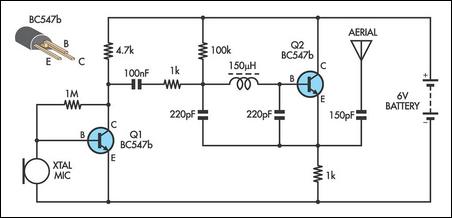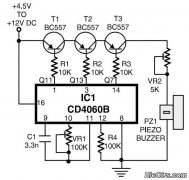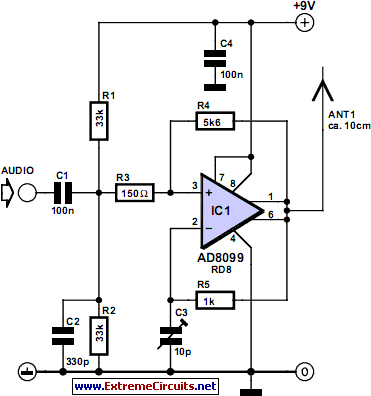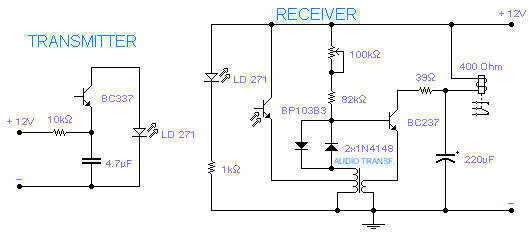
Simple AM Transmitter

This AM transmitter is designed for simplicity and ease of construction. It utilizes a single-winding inductor that is not tapped, eliminating the need for custom winding. A readily available RF choke, such as the Jaycar Cat LF-1536, can be used for this purpose. To minimize the size of the circuit, conventional tuning capacitors have been replaced with fixed 220pF capacitors. Tuning to a specific frequency can be achieved by reducing one or both of the 220pF capacitors to increase the frequency, or by adding capacitance in parallel to decrease the frequency. The transistor Q1 is biased with a 1MΩ resistor, providing high input impedance, which facilitates the use of a crystal earpiece as an economical microphone.
This AM transmitter circuit is characterized by its straightforward design, making it accessible for hobbyists and beginners in electronics. The choice of a non-tapped inductor simplifies the construction process, as it eliminates the complexity of winding the inductor. The use of a commercially available RF choke ensures that the inductor's specifications are suitable for AM transmission, allowing for reliable operation without the need for custom components.
The decision to replace the conventional variable tuning capacitor with fixed 220pF capacitors is a significant design choice that contributes to the compactness of the circuit. This modification streamlines the circuit layout and reduces the overall size, which can be particularly advantageous in applications where space is limited. The tuning method employed allows for fine adjustments in frequency, ensuring that users can easily achieve the desired transmission frequency by simply adjusting the capacitance values.
Transistor Q1 plays a crucial role in the circuit's performance. By biasing it with a 1MΩ resistor, the circuit achieves a high input impedance, which is essential for interfacing with low-output devices like crystal earpieces. This design choice not only enhances the circuit's sensitivity but also enables the use of cost-effective components, making the transmitter more affordable for users. Overall, this AM transmitter circuit exemplifies a practical and efficient approach to amateur radio transmission, combining simplicity, compactness, and cost-effectiveness.There are not many AM transmitters that are easier to build than this one because the inductor is not tapped and has a single winding. There is no need to wind the inductor as it is a readily available RF choke (eg, Jaycar Cat LF-1536).
To make the circuit as small as possible, the conventional tuning capacitor has been dispensed with and fixed 22 0pF capacitors used instead. To tune it to a particular frequency, reduce one or both of the 220pF capacitors to raise the frequency or add capacitance in parallel to lower the frequency. Q1 is biased with a 1MO resistor to give a high input impedance and this allows the use of a crystal ear piece as a low cost microphone.
🔗 External reference
This AM transmitter circuit is characterized by its straightforward design, making it accessible for hobbyists and beginners in electronics. The choice of a non-tapped inductor simplifies the construction process, as it eliminates the complexity of winding the inductor. The use of a commercially available RF choke ensures that the inductor's specifications are suitable for AM transmission, allowing for reliable operation without the need for custom components.
The decision to replace the conventional variable tuning capacitor with fixed 220pF capacitors is a significant design choice that contributes to the compactness of the circuit. This modification streamlines the circuit layout and reduces the overall size, which can be particularly advantageous in applications where space is limited. The tuning method employed allows for fine adjustments in frequency, ensuring that users can easily achieve the desired transmission frequency by simply adjusting the capacitance values.
Transistor Q1 plays a crucial role in the circuit's performance. By biasing it with a 1MΩ resistor, the circuit achieves a high input impedance, which is essential for interfacing with low-output devices like crystal earpieces. This design choice not only enhances the circuit's sensitivity but also enables the use of cost-effective components, making the transmitter more affordable for users. Overall, this AM transmitter circuit exemplifies a practical and efficient approach to amateur radio transmission, combining simplicity, compactness, and cost-effectiveness.There are not many AM transmitters that are easier to build than this one because the inductor is not tapped and has a single winding. There is no need to wind the inductor as it is a readily available RF choke (eg, Jaycar Cat LF-1536).
To make the circuit as small as possible, the conventional tuning capacitor has been dispensed with and fixed 22 0pF capacitors used instead. To tune it to a particular frequency, reduce one or both of the 220pF capacitors to raise the frequency or add capacitance in parallel to lower the frequency. Q1 is biased with a 1MO resistor to give a high input impedance and this allows the use of a crystal ear piece as a low cost microphone.
🔗 External reference





